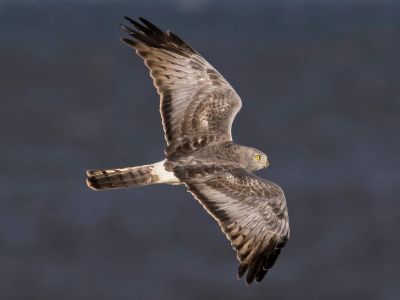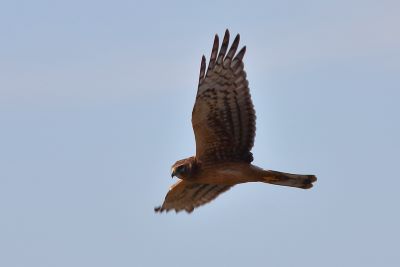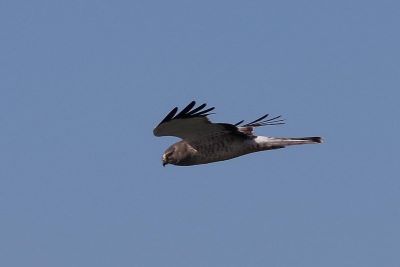
Formerly known as the Marsh Hawk, the Northern Harriers are slender, medium-sized raptors with long, fairly broad wings and a long, rounded tail. They have a flat, owl-like face and a small, sharply hooked bill. Harriers often fly with their wings held in a dihedral, or V-shape above the horizontal. They are a little bit bigger than a crow. All Northern Harriers have a white rump patch that is obvious in flight.
Northern Harriers fly low over the ground when hunting, weaving back and forth over fields and marshes as they watch and listen for small animals. They eat on the ground, and they perch on low posts or trees. On the breeding grounds, males perform elaborate flying barrel rolls to court females. Many Northern Harriers have been seen over the marsh at the SI crab dock.

MEASUREMENTS
- Both Sexes
- Length: 18.1-19.7 in (46-50 cm)
- Weight: 10.6-26.5 oz (300-750 g)
- Wingspan: 40.2-46.5 in (102-118 cm)
This is the call of a male northern harrier.

Male Northern Harriers can have as many as five mates at once, though most have only one or two. The male provides most of the food for his mates and their offspring, while the females incubate the eggs and brood the chicks.
Harriers are leapfrog migrants, with individuals from northern breeding populations wintering farther south than individuals from southern breeding populations. They usually migrate alone and during daytime, hunting as they go.

Harriers are of low conservation concern. Habitat loss has contributed to reduced harrier populations as people have drained wetlands, developed land for large-scale agriculture, and allowed old farmland to become reforested.
For information about the Northern Harrier visit
Resource: https://www.allaboutbirds.org/guide/Northern_Harrier/overview
Article submitted by: Melanie Jerome
Photographs provided by: Bob Mercer and Audubon Library
This blog post is part of a series SIB will publish on a regular basis to feature birds seen in the area, both migratory and permanent residents. When possible we will use photographs taken by our members. Please let us know if you have any special requests of birds you would like to learn more about.


